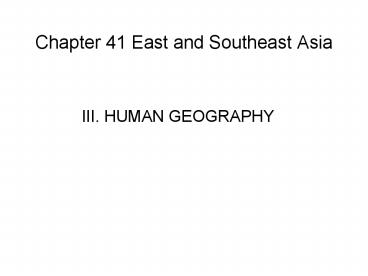Chapter 41 East and Southeast Asia - PowerPoint PPT Presentation
1 / 31
Title:
Chapter 41 East and Southeast Asia
Description:
The China flag contains a large yellow star and has a red background in honor of ... American combat troops were withdrawn. and South Vietnam was defeated by ... – PowerPoint PPT presentation
Number of Views:114
Avg rating:3.0/5.0
Title: Chapter 41 East and Southeast Asia
1
Chapter 41 East and Southeast Asia
- III. HUMAN GEOGRAPHY
2
A. Population and culture
- About 1/3 of the worlds people live in East and
Southeast Asia
3
A. Population and culture
- Population growth continues at a rapid rate
4
A. Population and culture
- Some nations now have programs to control their
population growth
A billboard in China promotes the one-child
policy introduced to curb the population increase
5
A. Population and culture
- A variety of cultures exists among the people of
the region
6
B. Language
- Hundreds of different languages are spoken
7
B. Language
- Some languages are character-based instead of an
alphabet of letters
character for cloud
character for rain
8
B. Language
- Many countries have adopted one official language
to unify the people
9
B. Language
- English is used as the business language of many
nations
10
C. Religion
- Most of the worlds major religions are
represented in the region
11
C. Religion
- Islam - the main religion in Indonesia, Malaysia,
and Brunei
12
C. Religion
- Christianity is practiced in areas once
controlled by Europeans
13
C. Religion
- Buddhism is a major religion in Thailand,
Myanmar, Laos, Cambodia, Vietnam, and Mongolia
14
C. Religion
- China has a mix of Buddhism, Taoism, and
Confucianism
42.2 are nonreligious 28.5 adhere to Chinese
folk religion 8.4 profess Buddhism 8.1 are
Atheists 7.1 are Christians 4.3 are
Muslims 1.5 are Taoists
15
C. Religion
- The Japanese mainly practice Shinto and Buddhism
16
D. Colonial history
17
D. Colonial history
- In the 18th and 19th centuries, many parts of
East and SE Asia came under the control of
foreign countries
18
D. Colonial history
- Great Britains colonies were Myanmar, Malaysia,
Singapore, Brunei, and Hong Kong
19
D. Colonial history
- The Netherlands controlled Indonesia
20
D. Colonial history
- Colonies of France were Cambodia, Laos, and
Vietnam
21
D. Colonial history
- Portugal had possession of the island of Timor,
and Macao
22
D. Colonial history
- The United States controlled the Philippines
23
D. Colonial history
- Leading up to World War II, Japans empire
included most of East and SE Asia
24
E. Post-World War II
- After WW II many countries sought independence
25
E. Post-World War II
- The Peoples Republic of China was established in
1949
The China flag contains a large yellow star and
has a red background in honor of communism. The
four smaller stars represent the four classes of
Chinese society, the peasant, the workers, the
bourgeoisie, and the capitalists
26
E. Post-World War II
- Early 1950s - the Korean War pitted South Korean,
U.S., and United Nations forces against North
Korea and China
27
E. Post-World War II
- No peace treaty was ever signed and tensions
between North and South Korea remain to this day
28
E. Post-World War II
- From 1956 to 1975,
- the Vietnam War
- saw the communist
- North fighting
- against democratic
- South
29
E. Post-World War II
- American combat troops were withdrawn
- and South Vietnam was defeated by the
- North
30
E. Post-World War II
- Vietnam was united under the control
- of a Communist government
31
F. Political geography
- Political systems vary widely throughout
- the region
- Communism in China and North Korea
- Dictatorship in Myanmar
- Democracy in Japan



























![Kennedy and Johnson Years [1960-1968]: chapter 21 PowerPoint PPT Presentation](https://s3.amazonaws.com/images.powershow.com/7273766.th0.jpg?_=20201226092)



